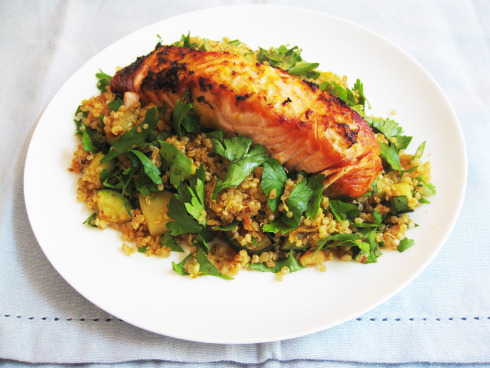Intermittent fasting hit the headlines last year, and hit fever pitch when Horizon broadcasted a programme by Dr Michael Mosley called Eat, Fast and Live Longer, which was watched by two and a half million people. IF is based on the premise that short periods of fasting enable you to shift weight and change shape – but the really incredible thing is that apparently it can radically transform your health as well. Scientific research shows that this age-old practice (dating back to the Ancient Greeks, as well as yogic traditions) of fasting for short breaks of time lowers the levels of a hormone called IGF-1 (Insulin-Like Growth Factor) and, in doing so, protects you from some of the major diseases, including cancer. It has also been shown that IF has potent anti-ageing benefits, and helps reduce inflammation which, in turn, helps with conditions such as eczema and asthma.
It’s a diet that is extremely easy to put into practice. There are 3 types of IF. You can follow the 16/8 plan – and eat healthily for 8 hours and fast for 16 (in other words either skip breakfast or dinner). Or you can try the 5/2 plan – and eat healthily for 5 days of the week and follow a 500-calorie diet for the other two. The final plan is the most full-on and least popular of all the plans – whereby you fast for one day and then eat healthily for the next. This is called alternate day fasting.
Sounds simple? It is! And that’s probably the main reason why it has become so popular so quickly. You choose the plan that seems right for you and then simply fast when you’re meant to. And when you’re not fasting, you eat healthily. A few IF diet books have been published recently, including one called Eat, Fast, Slim by Amanda Hamilton. The beauty of Amanda’s book is that she shows you all the types of fasting but also shows you how to ensure it’s a superhealthy diet for you. It’s important to ensure that you balance the types of food you’re eating, and especially that you get enough protein and nutrients during the plan. Amanda explains the diets, and explains what you’ll get out of them. And then gives you Fasting Plans and a whole load of mouth-watering recipes.
I tried the Grilled Salmon with Harissa Quinoa and it was delicious. The lime-zesty salmon along with the harissa-spicy quinoa was a great combination. And the colours and textures of the food were lovely. Hmmm I think I might even try this IF dieting!
* gluten-free, dairy-free, yeast-free, egg-free, soya-free, nut-free, seed-free
- 140g/5oz salmon fillet
- zest and juice of ½ lime
- 40g/1½oz/scant ¼ cup quinoa
- 1 tsp olive oil, plus extra for brushing
- 3 spring onions, white part only, thinly sliced
- ¾ courgette, diced
- 1 tsp harissa paste
- 2 tbsp chopped coriander leaves
- lime wedge, to serve
- Put the salmon on a plate and rub the lime zest over the flesh, then sprinkle with half the lime juice. Cover with cling film and leave to marinate at room temperature for 5 minutes.
- Put the quinoa in a sieve and rinse well under cold running water. Put it in a saucepan and cover with 160ml/5¼fl oz/2⁄3 cup boiling water. Bring to the boil, then reduce the heat and simmer for 15 minutes.
- Brush the grill rack with oil and preheat the grill to medium. Put the salmon on the grill rack and grill for 5–6 minutes on each side or until cooked through and the flesh is opaque.
- Meanwhile, heat the oil in a nonstick frying pan over medium heat. Add the spring onions, courgette and harissa paste, and cook for 2–3 minutes, stirring frequently, until the vegetables start to soften. Remove the pan from the heat, add the quinoa and its cooking liquid and toss to coat with the harissa. Cover with a lid and leave to stand for 5 minutes or until all the liquid has been absorbed, then fluff up with a fork and stir in the coriander and remaining lime juice.
- Serve the salmon with the quinoa and a lime wedge on the side for squeezing over.







Leave a Reply